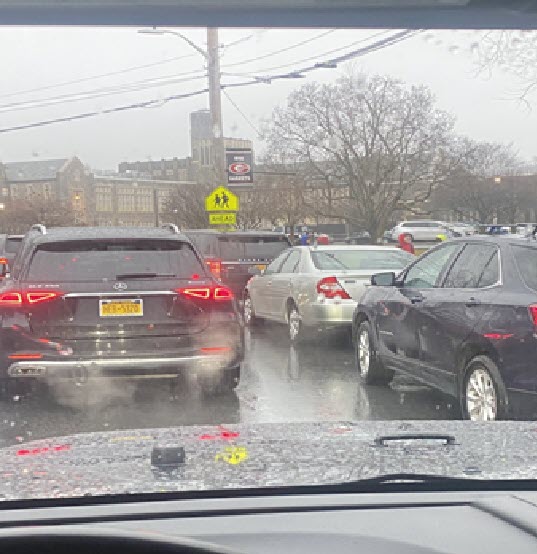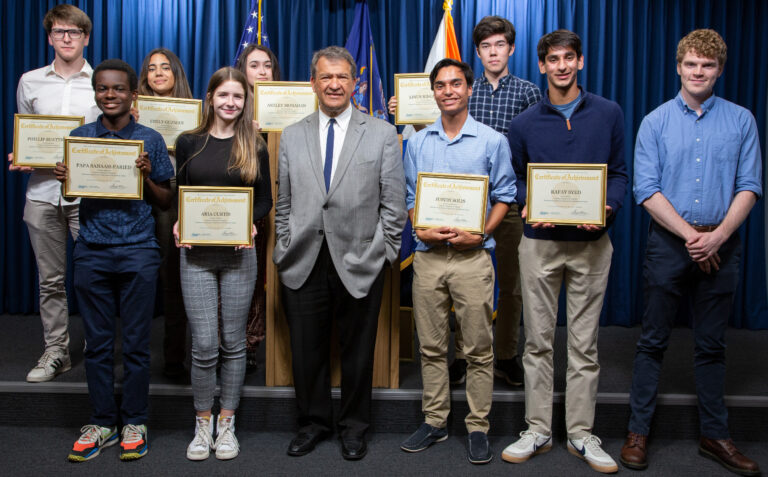RHS Academy on Green Issues: Impact of School Drop-Off & Pick-up on Our Health

Recently, students at The Academy at Rye High School, a project based learning program, looked at a variety of environmental issues. MyRye.com will bring you a few of these projects in the run up to Earth Day on Saturday, April 22nd.
Today, junior Spencer Boxford of Soundview Avenue looks at carbon emissions and the alarming impact of school drop-off and pick-up times on the environment and our health.
By RHS junior Jack Acciavatti
At 7:38am, every morning, I open my front door and turn on my Jeep, a gasoline vehicle. I drive up my street and onto Boston Post Road. Once I near Rye High School, I soon find myself in traffic. In this traffic, I sit idly, amongst 30 other cars, for around 6 minutes before I eventually make the turn onto Parsons Street, where I sit in another 4 minutes of traffic. Once these 4 minutes have ended I turn onto Milton Road, which contains 2 minutes of traffic, and finally, I turn left onto Apawamis Street, where I park.
My daily 12-minute journey is one taken, in some form, by a majority of the 500 juniors and seniors at Rye High School, along with hundreds of parents and I’m sure a similar journey is taken by many students and parents across the country. These short drives seem harmless but when done over and over for 190 days a year, they produce massive amounts of carbon, along with other greenhouse gasses, which impacts not only the environment but children’s health as well.
It has become common knowledge that the use of gasoline cars contributes to the already worsening issue of climate change, but the specifics and the true impact of carbon emissions aren’t as commonly known. According to the EPA (United States Environmental Protection Agency) in Greenhouse Gas Emissions from a Typical Passenger Vehicle,
- 8,887 grams of carbon dioxide (CO2) are produced per gallon of gasoline,
- 10,180 grams of carbon per gallon of diesel and 404 grams of carbon dioxide are produced per mile,
- And the average passenger vehicle can travel 20-30 miles per
Assuming the average Rye High School student is around a 1.5-mile trip away from school, travels in a gasoline vehicle, and their vehicle can travel 25 miles per gallon, 666.25 grams of carbon dioxide are produced every time they travel to and from school. This 666.25 grams of carbon dioxide then enters the atmosphere. But, how does this impact the environment?
Carbon dioxide is crucial to all life and one of its main purposes is to warm the Earth. Carbon acts in a similar way to glass in a greenhouse, meaning it traps heat and in doing so warms the planet. In addition, according to the Law of Conservation of Mass, matter can not be created or destroyed, and just like every piece of matter on this planet, this law applies to carbon dioxide. This means that a fixed amount of carbon dioxide exists on this planet, and it lives in a cycle. As defined by the DOE (Department of Energy) in The DOE Explains the Carbon Cycle, “The carbon cycle is the process that moves carbon between plants, animals, and microbes; minerals in the earth; and the atmosphere.” This cycle serves to maintain a balance between the amount of carbon in the atmosphere and the troposphere (The ground) which ensures the planet is hospitable. So, every time this 666.25 grams of carbon is produced, excess carbon is transferred to the atmosphere. This number begins to add up, quite significantly, over the course of the school year, as the drive to Rye High School is taken twice a day, for around 190 days a year, by close to one thousand students and parents.
With excess carbon entering the atmosphere, the environment has been impacted massively, which in turn can affect the health of all living things, particularly the health of those who spend significant time around this pollution, such as children in school zones. As stated by Rebecca Lindsey in Climate Change:
Atmospheric Carbon Dioxide, excess carbon in the atmosphere amplifies the natural greenhouse effect of carbon, results in warming global temperatures. This temperature rise can and has led to an increase in global sea levels, the intensity of weather conditions, and has led to significant damage to infrastructure across the world, including Rye.
In addition, tailpipe emissions–a category carbon falls within–in the atmosphere have been directly connected to various health issues. These issues include asthma, greater risk of cancer, cardiovascular disease, autism spectrum disorder, childhood obesity, and delayed cognitive development, just to name a few. These health risks can affect people of all ages, but according to the EPA in Traffic Emission Impacts on Child Health and Well-being “children from infancy to the age of 14 are especially susceptible…due to their rapidly developing immune, neurologic, and lung systems and high ventilation rates.” This age range includes elementary school students, middle school students, and even high school students, all of whom are exposed to these toxic emissions.
As I stated earlier, pick-up and drop-off times at Rye High School produce large amounts of carbon, and as a result, the environment and children’s health are impacted, but there are ways the production of carbon and other greenhouse gasses can be reduced. While the implementation of a busing system and the entire Rye community purchasing electric vehicles will reduce carbon emissions, these are quite ambitious goals. Alternative methods, that are far cheaper and more efficient include,
- Being conscious of how hard you press down on the gas pedal and brakes,
- Getting regular tune-ups for your car and using the recommended motor oil,
- And reducing the amount of time you idle your car or ideally don’t idle it at
While the use of gasoline vehicles is a very important issue that needs to be addressed, it only makes up a percentage of the world’s overall carbon emissions. For example, manufacturing, electricity, and agriculture are all substantial sources of carbon. If you wish to learn more about this topic and how you can decrease your carbon footprint, please visit Calculating Your Carbon Footprint.





